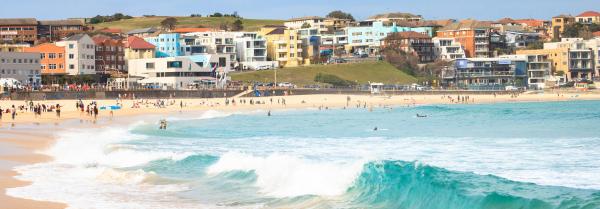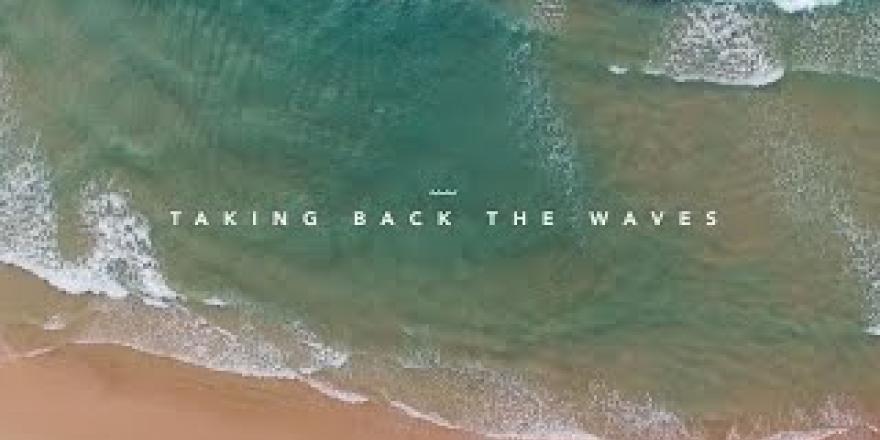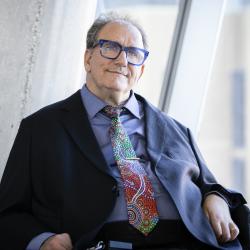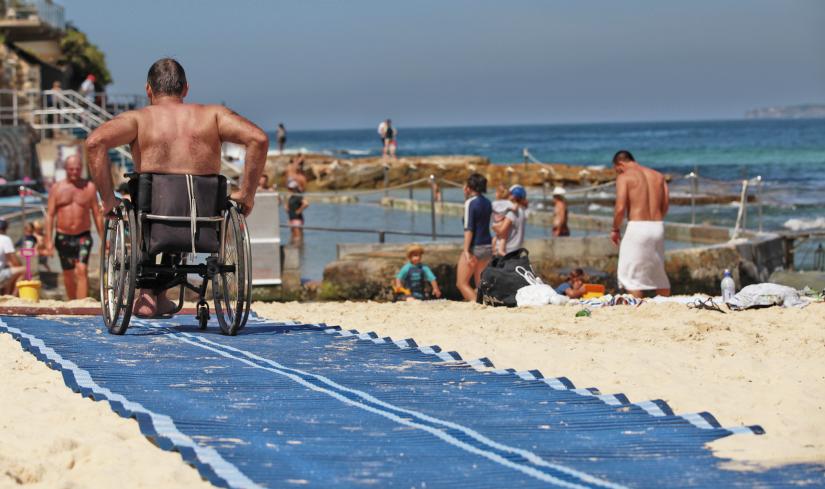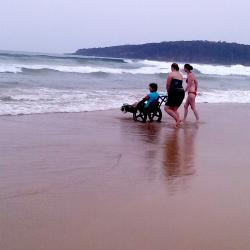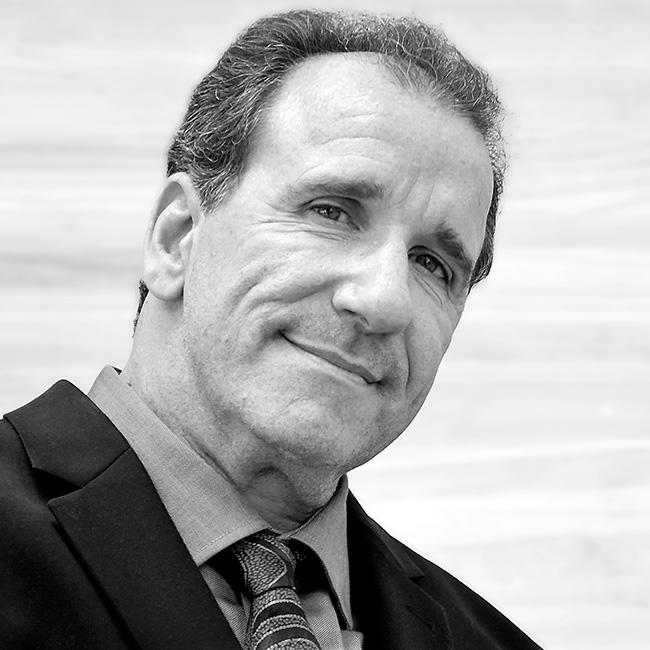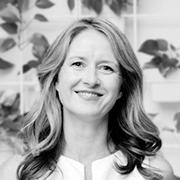“Some of the most universal human experiences can be inaccessible because no one has thought about the access needs of people with disabilities,” says Paralympian and disability advocate Paul Nunnari.
“In some ways, the beach is our last domain to conquer. Making our beaches accessible to everyone is a no-brainer. But the truth is many beaches up and down our coast don't yet have equipment like access ramps or programs that are needed to include people with disability.”
Professor Simon Darcy, from the UTS Business School and co-lead of the UTS Disability Research Network, understands this reality firsthand. He was a keen board rider and surf lifesaver on Sydney’s northern beaches before a serious accident at 19 left him with a complete spinal cord injury and as a power wheelchair user.
“Beaches are home to the body beautiful and can be intimidating places even for people without disability. So how do we make them truly open places that are accessible and inclusive to people who don’t fit the social perceptions of the bodily norm?” he asks.
“Even simple things can be a challenge whether it’s finding an accessible parking spot close to the sand, an access ramp that’s not too steep, or a changeroom that caters to our needs.”
Several years ago, Professor Darcy and his team (Dr Mel Edwards, Dr Hazel Maxwell and Barbara Almond) started partnering with Surf Life Saving NSW, building on his previous work with the national body Surf Lifesaving Australia.
Their research focussed on the organisation’s community inclusion program to improve access for people with disability at three NSW beach precincts – at Sydney’s iconic Bondi Beach, in Newcastle and at Pambula on the south coast.
They took a community development and social relational model of disability to understand the impact of some 30 different community inclusion projects that had been completed by Surf Life Saving NSW in conjunction with local councils and not-for-profit organisations.
Access all areas
The first part of the research was to establish a baseline of the relative accessibility and program offerings in each of the beach precincts. This was completed by the team in conjunction with an accredited access auditor.
“A major local government infrastructure project was undertaken at each of the beaches. We then ran a series of action-research engagements over two years looking at other aspects of access and inclusion of the community inclusion projects” he explains.
“We focussed on all types of disability – mobility, intellectual, vision/blind, hearing/Deaf and mental health – and all levels of support needs from people who are independent with disability through to people requiring high levels of social or physical support together with assistive technology.”
"A great deal of effort had been put into improving the infrastructure to help people get down to the beach."
We were looking at the next step where they could stake out a space that is theirs – where they, their family and friends could feel welcomed and have a sense of belonging.
- Professor Simon Darcy
If you can't park or pee, you can't participate
“How do we get someone with a disability into the water, first via a pool and then into the ocean itself, and then even onto the peak experience of catching a wave?”
Their research found the first steps towards accessing these experiences happen away from the sand.
At each of the beach precincts, they ran observation studies on how people with disability were welcomed into the space and place, whether that was on surrounding grass areas, the sand itself or into the water.
One project involved looking at ways people with a disability could feel like they belong at the beach with their family and friends. This was found to be particularly challenging.
With a different sense of belonging for people with mental health disabilities, a number of projects enabled individuals to connect with others so they felt supported in the surf environment.
But for other groups, it was more about challenges with the built and natural environment to participate in community events.
“People at the beaches were generally very welcoming and this was particularly so where a group with mobility disabilities had set up their spot with banners and their assistive equipment,” Professor Darcy explains.
“But there were no accessible change rooms as they were being redeveloped so we were holding up towels while people were getting their togs on.”
“It served to underline a basic principle around access for people with mobility disability: if you can’t park and you can’t pee, you can’t participate.”
While many beaches have the physical equipment like beach wheelchairs and matting, there’s a big difference between having equipment and being able to use it.
“We found a number of operational issues about how to get to a beach wheelchair when it’s locked up and surf lifesavers aren’t available with the keys.”
Combined with other initiatives, practical changes in the way accessibility infrastructure is being delivered at different beaches across the state are being now implemented.
Co-designing transformative solutions
Perhaps more importantly, they showed the value of taking a holistic approach to accessibility in the local area that puts the voices of people with disability and their communities at their centre.
“We saw this at places like Pambula. The fact that everyone knows everybody else meant the different programs were far more interconnected and personal. They now have a very active group around children with disability and their Nippers program,” Professor Darcy says.
“Local community groups and councils also play a critical role in the inclusion process and investing in improving their capacity can really pay dividends.”
The final part of the research discussed the importance of developing co-designed transformative solutions where the lived experience of those involved is not just valued, but becomes central to the solutions.
We might look different to the average beach goer, but the goal is for everyone to feel supported and have fun. Here are groups of people with disability with their family and friends and its amazing to watch them become part of the scene.
- Professor Simon Darcy
For advocates like Paul Nunnari, research like this is the starting point for enabling more people with disability to get their feet on the sand or in the water.
“Programs such as these are seeing accessibility improving as we've come more aware of the barriers faced by people living with disability and how we can overcome them,” he says.
“It's my hope that there’s a new future where having a disability won't stop anyone from enjoying our great beaches and unique way of life.”
⇢ Read the paper 'Disability inclusion in beach precincts: beach for all abilities", Sports Management Review, Vol.26, 2023 - Issue 1
Research team
-
Co-Lead, UTS Disability Research Network
-
University of Technology Sydney
-
University of Technology Sydney
-
Western Sydney University
Partners
Surf Lifesaving NSW
Waverley Council
Newcastle City Council
Bega Valley Shire Council
